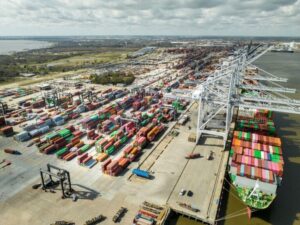Import cargo volume at the USA’s major container ports is expected to climb toward an August peak this summer, according to the Global Port Tracker report released by the National Retail Federation and Hackett Associates.
And while that is cause for optimism, the National Retail Federation (NRF) noted that even though a tentative contract agreement has been reached at West Coast ports, retailers are closely following labor disputes at ports in western Canada, and a potential Teamsters strike against United Parcel Service.
U.S. ports covered by Global Port Tracker handled 1.93 million teu in May, the latest month for which final numbers are available. That was up 8.5% from April but down 19.3% year over year.
Ports have not yet reported June numbers, but Global Port Tracker projected the month at 1.86 million teu, down 17.5% year over year. That would bring the first half of 2023 to 10.6 million teu, down 22% from the first half of 2022.
July is forecast at 1.94 million teu, down 11% year over year, and August is forecast at 2.03 million teu, down 10.1% year over year but the first month since last October to reach 2 million teu.
”We were relieved that labor and management at West Coast ports reached a tentative agreement last month but that doesn’t mean supply chain disruptions are over,” NRF Vice President for Supply Chain and Customs Policy, Jonathan Gold, said.
Gold pointed out that “the port strike affecting Vancouver and Prince Rupert shouldn’t have a major impact here but could affect some US retailers whose merchandise comes in through Canada and could have a potential ripple effect at other ports. Meanwhile, the ability to move goods from U.S. ports to stores could be impacted if UPS and the Teamsters don’t resolve their differences before their contract expires at the end of the month”.
Gold added that ”we urge all parties in both negotiations to get back to the table and continue efforts to reach a final deal without engaging in disruptive activity. Seamless supply chains are critical for retailers as we head into the peak shipping season for the winter holidays.”



